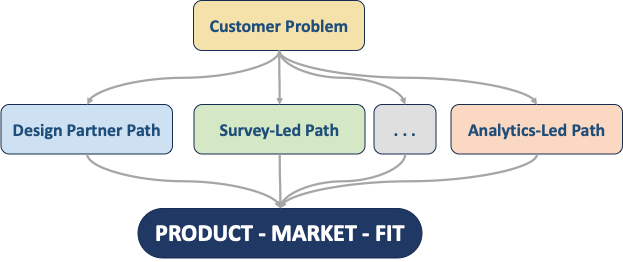Cracking the Product-Market-Fit Code
5 Proven Paths to Product-Market Fit for B2B Tech Startups
Product-Market Fit (PMF) is achieved when a startup's product solves a proven, acute problem for a well-defined target market-so effectively that customers use and recommend it enthusiastically, and sales grow without disproportionate effort. In practical terms, PMF means strong demand, clear customer pull, high user retention or repeat business, and clear evidence that your offering has found its "place" in the market
For B2B tech startups, reaching product-market fit is the point where:
Customers genuinely value the product (often describing it as a "must-have").
Users or buyers are willing to pay, expand usage, and recommend it to peers.
Growth starts to accelerate due to word-of-mouth and satisfied customers.
The company has evidence-based clarity on who its best customers are and why.
As Marc Andreessen famously put it:
Product-Market-Fit means being in a good market with a product that can satisfy that market
1. Design Partner & Pilot-Driven Validation
Overview:
Cultivate close relationships with early adopter customers who co-create the product through feedback, pilots, and deep iteration. This ensures development focuses on real-world pains from the start.
Best Practices:
Find and onboard strategic "design partners" in your ICP.
Iterate alongside partners, treating pilots as learning labs.
Let their needs and "pull" shape your roadmap.
Success Story:
Pilot's founders worked hand-in-hand with select customers, constantly refining their finance SaaS platform. This collaborative approach allowed Pilot to gain rapid traction in a market dominated by Intuit.
Full story: Pilot’s Path to Product-Market-Fit
2. Quantitative "Product-Market Fit Engine"
(A Survey-Driven Approach)
Overview:
Use data-driven surveys to systematically gauge and improve customer love, focusing on their "must-have" sentiment-often via the Sean Ellis test ("how would you feel if you could no longer use this product?").
Best Practices:
Regularly survey users about indispensability.
Double down on what "very disappointed" users love.
Ignore noise from non-core segments.
Success Story:
By surveying users and focusing only on the power users' feedback, Superhuman dramatically grew its PMF score and loyalty among its HXC (High eXpectation Customers).
Full story: How Superhuman Built an Engine to Find Product-Market-Fit
3. Rapid Iteration & Pivot Based on Early Usage Analytics
Overview:
Obsessively monitor product usage, retention, and engagement data to let real-world metrics-not assumptions-drive your product evolution, even if it means pivoting to a new market or use-case.
Best Practices:
Deeply instrument product and track activation, retention.
Analyze which features drive recurring, meaningful engagement.
Be unafraid to change course if the data demands it.
Success Story:
Slack's founders pivoted after seeing strong organic engagement from early users. Relentless focus on user retention and onboarding drove runaway growth.
Full story: How Slack found its First Customers
4. Niche Focus & Community-Empowered Growth
Overview:
Nail PMF in a tightly defined initial segment or community, build word-of-mouth evangelism, and expand outward only when your solution is indispensable to that niche.
Best Practices:
Identify a concentrated group with clear, shared needs.
Build credibility and trust within the community.
Enable and reward organic advocacy.
Success Story:
Linear focused on developers and early-stage startups, delivering a beautifully designed issue-tracking tool that became beloved-and widely adopted-by its community before expanding wider.
Full Story: Linear app built $400m issue tracker with next to no marketing
5. Problem-First, Pain-Point Obsession
Overview:
Start by deeply understanding (and validating) the customer's sharpest pain, letting the "hair-on-fire" problem-not your technology or feature list-guide your MVP. Test willingness to pay early.
Airbnb reached PMF by running high-touch founder experiments, obsessively learning from guest and host data, and rapidly iterating on design and market assumptions.
Instacart built initial PMF by obsessively solving for users who wanted fast grocery delivery, then scaling via retailer partnerships for true network effects.
Best Practices:
Conduct in-depth interviews to understand daily pain points.
Build and test solutions only for validated, acute problems.
Charge for value early-even at a small scale-to test true demand.
Success Story:
Airbnb and Instacart centered on painful problems and found early traction by solving them sharply.
Full Story:
Conclusion and Key Message:
Product-Market Fit is not a formula, but a relentless quest to prove your solution belongs in your market-measured by true customer pull, retention, and word-of-mouth. Whether you partner closely with early adopters, use actionable metrics, double down on a niche, or obsess over problem validation, the common thread is customer-driven learning, disciplined iteration, and the courage to pivot.
Above all:
Startups that find product-market fit are those who listen hardest, adapt fastest, and never stop anchoring their efforts in the real needs and love of their best customers.
Product-Market-Fit success Stories for Inspiration:
Zapier’s Concierge MVP story (YouTube Video)
Expensify’s Go-To-Market evolution (Interview with the Founder)
Tray.io on building an embedded iPaaS (Interview with the Founder)




